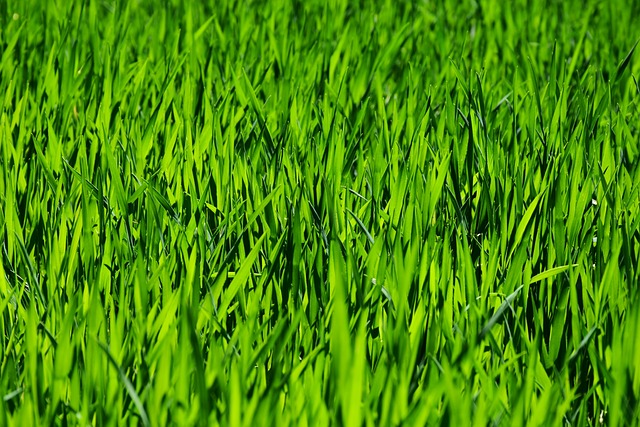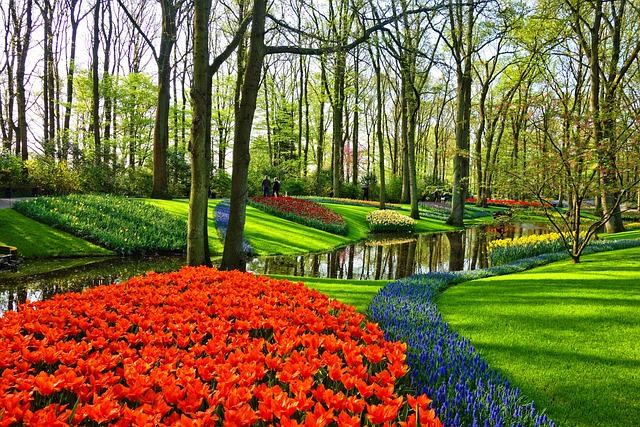Mulching is essential for maintaining soil health and turf resilience by conserving moisture, moderating temperature extremes, and inhibiting weed growth. Organic mulch not only enriches the soil over time but also helps retain moisture longer, reducing water usage and aiding the lawn during drought or high temperatures. When combined with precise edging to define lawn boundaries, these practices suppress weeds and promote a uniform, aesthetically pleasing look. Edging is crucial for maintaining clean and distinct landscape edges, which enhances visual harmony and the overall appeal of your yard. The choice between manual and mechanical edging tools should be based on your lawn's size, edge complexity, and personal preference. Regular edging is key to ensuring each area of the landscape receives proper care, leading to a more manicured, professionally maintained appearance that adds artistic value to your home's exterior. By integrating both mulching and edging into your lawn care and landscaping routine, you can achieve a healthy, lush lawn that reflects meticulous attention and care, emphasizing sustainable and resource-efficient practices in lawn maintenance.
Title: “Mulching and Edging Mastery: Elevate Your Lawn’s Appeal and Health”
A well-manicured lawn is a hallmark of curb appeal and environmental stewardship. This article delves into the pivotal practices of mulching and edging within the realm of lawn care and landscaping, revealing their profound impact on lawn health and aesthetics. Discover how these techniques not only enhance the visual allure but also fortify the soil, ensuring a vibrant, resilient landscape. Through a detailed exploration of ‘Optimizing Lawn Health: The Role of Effective Mulching in Lawn Care and Landscaping’ and ‘Precision and Aesthetics: The Art of Edging for a Manicured Lawn in Lawn Care and Landscaping’, learn how to integrate mulch and edging for a lawn that not only captivates but also thrives. Join us as we uncover the best practices for integrating these essential lawn care elements, culminating in ‘Integrating Mulch and Edging Techniques for Enhanced Curb Appeal and Soil Health in Lawn Care and Landscaping’.
- Optimizing Lawn Health: The Role of Effective Mulching in Lawn Care and Landscaping
- Precision and Aesthetics: The Art of Edging for a Manicured Lawn in Lawn Care and Landscaping
- Integrating Mulch and Edging Techniques for Enhanced Curb Appeal and Soil Health in Lawn Care and Landscaping
Optimizing Lawn Health: The Role of Effective Mulching in Lawn Care and Landscaping

Effective mulching plays a pivotal role in maintaining a lush, healthy lawn as part of comprehensive lawn care and landscaping practices. Mulch acts as a protective barrier that conserves soil moisture, moderates soil temperature, and inhibits the growth of weeds. By applying a generous layer of organic mulch around grass plants, lawn care professionals can ensure that the soil retains moisture for an extended period, reducing the frequency of watering required. This not only saves water but also fosters a more resilient turf capable of withstanding periods of drought or high temperatures. Moreover, as the mulch decomposes, it enriches the soil with essential nutrients, further promoting grass health and growth. When integrating mulching into your lawn care and landscaping routine, consider the type of mulch suitable for your local climate and the specific needs of your lawn. A well-mulched lawn is a testament to thoughtful landscaping that combines aesthetic appeal with practical soil management.
In addition to its moisture-retaining properties, mulching also contributes to weed suppression, which is crucial for preventing competitive plants from outcompeting your grass. This not only enhances the visual uniformity of the lawn but also reduces the need for herbicides. The process of edging, which defines the clear boundary between your lawn and garden beds or sidewalks, complements mulching by minimizing the encroachment of grass onto non-turf areas, where it would compete with desired plants. Together, these practices, when performed diligently as part of your lawn care and landscaping strategy, can significantly improve the health and appearance of your lawn, creating an outdoor space that is both inviting and well-maintained.
Precision and Aesthetics: The Art of Edging for a Manicured Lawn in Lawn Care and Landscaping

Edging is a meticulous aspect of lawn care and landscaping that delineates the boundaries between a lush lawn and garden beds, walkways, or flowerbeds. This practice not only prevents grass from encroaching on other areas but also enhances the overall aesthetic appeal of the landscape. A precise edging job is crucial for maintaining the clean lines that define a manicured lawn. The tools available for this task range from manual spade edges to gas-powered boundary maintainers, each offering a different level of precision and effort required. In landscaping, aesthetics are paramount, and edging plays a significant role in achieving a polished, well-groomed look. The choice between manual and mechanical edging depends on the size of the lawn, the complexity of its borders, and the individual’s preference for physical exertion versus machine efficiency. Regardless of the method chosen, regular edging is essential to maintain the separation between different landscape elements, ensuring that each area receives the appropriate care and attention it requires. This not only contributes to a healthier lawn but also elevates the visual impact of the yard, making it a focal point of beauty and tranquility in any residential setting. Lawn care and landscaping professionals emphasize the importance of this practice, as it is a foundational element in creating and maintaining a pristine outdoor space that invites appreciation and showcases the artistry within garden design.
Integrating Mulch and Edging Techniques for Enhanced Curb Appeal and Soil Health in Lawn Care and Landscaping

When it comes to maintaining a lush, vibrant lawn, integrating mulch and edging techniques plays a pivotal role in enhancing both curb appeal and soil health within lawn care and landscaping practices. Mulching, the practice of spreading a protective covering over the soil, serves multiple functions. It helps to retain soil moisture, suppress weeds, and improve soil quality over time. Organic mulches like wood chips or straw break down gradually, enriching the soil with valuable nutrients that benefit grass growth and root development. Additionally, mulch acts as an insulator, moderating soil temperature fluctuations, which can be particularly advantageous in regions with extreme weather conditions.
Edging, another essential lawn care practice, delineates the boundaries between different landscaping elements, such as lawns, flower beds, and pathways. A well-defined edge not only contributes to a tidy and manicured appearance but also prevents grass from encroaching onto unwanted areas, which can lead to turf diseases and an unkempt look. Edging helps to channel water where it’s most beneficial and can prevent soil compaction around the edges of your lawn. When combined with mulching, edging can create a clear line that showcases the manicured lawn, contributing to the overall aesthetic appeal of the property. This integration also allows for better management of resources like water and fertilizer, directly impacting the health and resilience of the turf. Incorporating these lawn care and landscaping techniques not only elevates the visual allure but also fosters a thriving ecosystem beneath the grass, ensuring that your lawn stands out as a testament to careful planning and maintenance.
Effective mulching and precise edging are indispensable practices for those committed to lawn care and landscaping. By implementing these techniques, homeowners can achieve a visually appealing, well-maintained lawn that not only boosts curb appeal but also fosters soil health and plant growth. The synergy between mulch and edging creates an environment where lawns thrive, with a clean, defined border that enhances the aesthetic value of any property. For those seeking to elevate their lawn care and landscaping efforts, integrating these strategies is a wise choice for both immediate visual impact and long-term lawn vitality.
